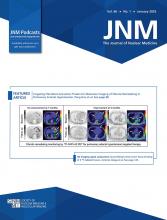Visual Abstract
Abstract
High-volume disease (HVD) and low-volume disease (LVD) definitions in metastatic hormone-sensitive prostate cancer (mHSPC) patients are based on conventional imaging (CI) (CT/MRI with bone scan [BS]) according to CHAARTED criteria. HVD and LVD definitions are associated with overall survival and are used for treatment decisions. It remains unknown how these definitions transfer to prostate-specific membrane antigen (PSMA) PET imaging. The aim of this retrospective multicenter study was to compare the CI-based disease volume criteria to PSMA PET–based volume definitions in a CHAARTED-like cohort. Methods: mHSPC patients from 5 international sites who underwent PSMA PET/CT or PSMA PET/MRI and BS within a time interval of 100 d and without initiation of a new therapy between the 2 scans were retrospectively included in the analysis. CHAARTED HVD and LVD criteria were applied to BS, CT, MRI, and PSMA PET. HVD was defined by the presence of visceral metastases or at least 4 bone metastases (with ≥1 beyond the spine or pelvis). Whole-body (WB) tumor burden was estimated with the automated bone scan index (aBSI, EXINI v2.0) on BS and with the WB PSMA PET–positive tumor volume (PSMA-TV) on PSMA PET, respectively. Results: Sixty-seven patients with paired PSMA PET and BS were included. The median prostate-specific antigen level was 54.9 ng/mL (interquartile range [IQR], 10.4–191.0 ng/mL). On the basis of CI, it was determined that 17 of 67 patients had HVD-CI (25.4%) and 50 of 67 patients had LVD-CI (74.6%). On the basis of PSMA PET, it was determined that 27 of 67 patients had HVD-PET (40.3%) and 24 of 67 patients had LVD-PET (35.8%). In total, 16 of 67 patients (22.4%) had no visible lesion or only locoregional pelvic disease (M0) with PSMA PET (M0-PET). Stage migration between CI and PSMA PET occurred in 27 of 67 patients (40.3%) by both upstaging and downstaging: 11 of 50 (22%) LVD-CI patients were HVD-PET, whereas 1 of 17 (5.9%) HVD-CI and 15 of 50 (30%) of LVD-CI patients were M0-PET. The median WB PSMA-TV and automated BS index were 248.0 mL (IQR, 54.6–1,427.0 mL) and 3.4% (IQR, 1,0–7.2%) for HVD-CI, 25.1 mL (IQR, 6.6–74.6 mL) and 0.1% (IQR, 0.0–0.2%) for LVD-CI, 141.0 mL (IQR, 47.5–458.0 mL) and 0.9% (IQR, 0.04–4.1%) for HVD-PET, and 31.5 mL (IQR, 10.1–67.9 mL) and 0% (IQR, 0–0.1%) for LVD-PET, respectively. The optimal WB PSMA-TV to stratify CI-based CHAARTED LVD-CI versus HVD-CI was 107 mL with a misclassification of 21.9%. Conclusion: Compared with CI, addition of PSMA PET leads to M0 downstaging in every third and LVD to HVD upstaging in every fifth mHSPC patient. Future HVD and LVD definitions based on PSMA PET/CT should be adjusted based on patient outcome.
- © 2025 by the Society of Nuclear Medicine and Molecular Imaging.
This article requires a subscription to view the full text. If you have a subscription you may use the login form below to view the article. Access to this article can also be purchased.
SNMMI members
Login to the site using your SNMMI member credentials
Individuals
Login as an individual user








